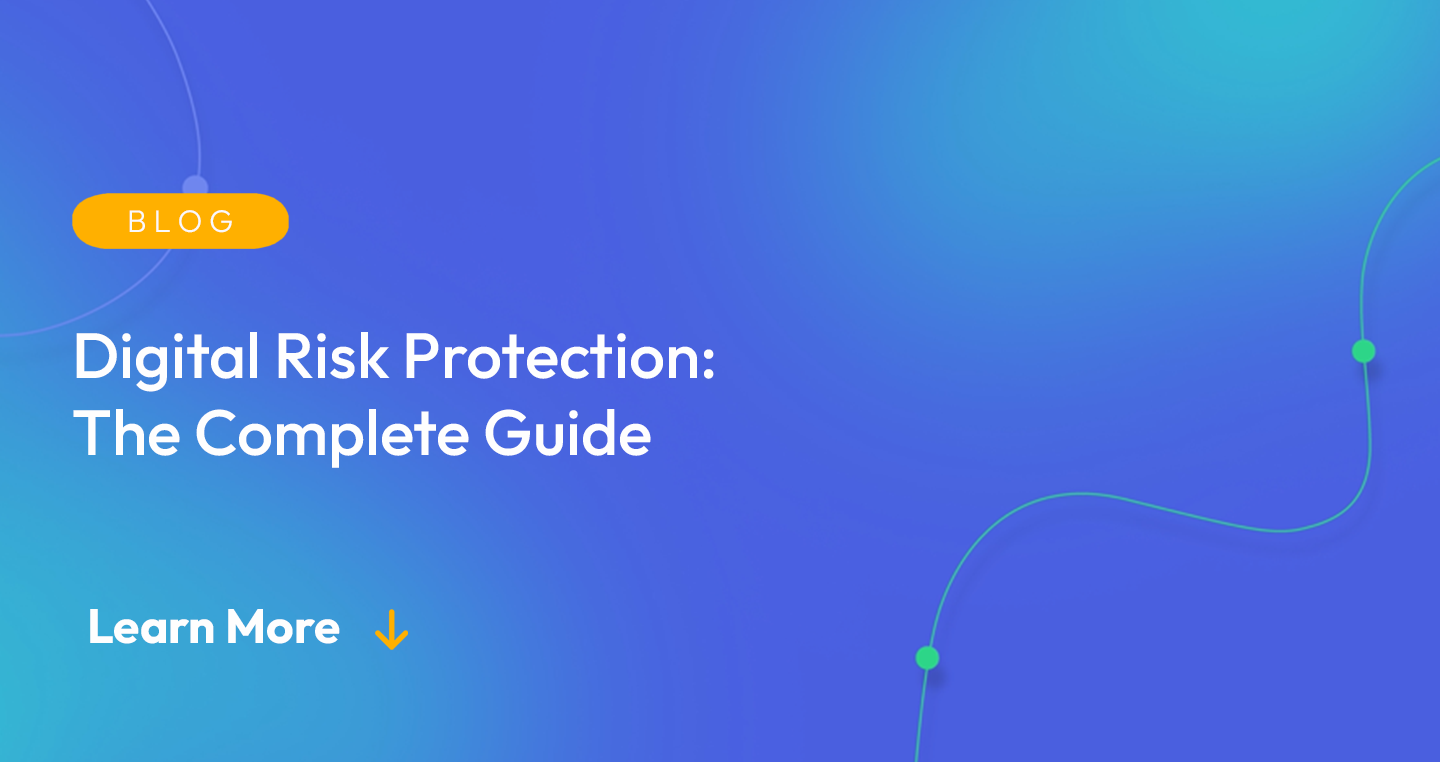
Cybersecurity no longer stops at the network boundary. The past decade has seen the proliferation of online threats, many of which companies are entirely unaware of. Users’ credentials are sold on the dark web to facilitate account takeover schemes, sensitive customer data is leaked or traded for bitcoin, and companies regularly lose highly sensitive technical data to accidents, misconfiguration, and insider threats.
Implementing a digital risk protection (DRP) software platform into your cybersecurity posture can help you understand, reduce, and mitigate risk to your organization.
What Is Digital Risk Protection?
Digital risk protection involves scanning resources to look for exposed credentials, leaked technical data, financial fraud, phishing attempts, and other sensitive company information. If sensitive data is discovered, either manual or automated mitigation actions are taken. The type of mitigation varies based on the risk.
For example, if an organization finds that its Amazon S3 buckets are misconfigured, all that might be required is a simple reconfiguration to protect confidential information. Conversely, if an organization finds that thousands of its corporate email addresses are compromised on the dark web, major investigation and remediation efforts need to be taken.
Building DRP into existing cybersecurity workflows allows organizations to:
- Map their external risks
- Discover previously unknown risks
- and effectively mitigate unacceptable risks
Digital risk protection is a relatively new category of cybersecurity, and many organizations are choosing to add a DRP solution to their existing cybersecurity stack rather than replace existing solutions. In the same way that SIEM tools enable organizations to fully map their existing internal cybersecurity posture, DRP solutions enable organizations to monitor external threats.
Why Is Digital Risk Protection Important?
Ransomware attacks, supply chain disruptions, and account takeovers have never been more common. The threat landscape has dramatically expanded, and many cybersecurity programs are struggling to keep up.
Our increasingly digital and integrated economy has opened up enormous opportunities for malicious actors to launch attacks that are often rewarded with millions of dollars in ransoms or other profits. In fact, it’s estimated that ransomware victims lost over 3.4 billion dollars in 2019, a figure that has likely grown significantly since. Attack surfaces have dramatically expanded while organizations have struggled to defend their digital assets from cyber-attacks.
A recent Flare report found that ransomware attacks increased by over 748% in 2019 alone.
Companies that fail to take digital risk protection seriously risk opening a large gap in their corporate cybersecurity program that could leave them vulnerable to phishing, account takeover, and other threats that could have easily been mitigated with proper visibility.
Digital risk protection software can help you monitor the deep and dark web for digital threats, expand your detection and response capabilities, and provide you with invaluable threat intelligence tools.
What Are the Main Use Cases for Digital Risk Protection?
Building DRP into your existing cybersecurity workflow can alert you to a variety of issues. Here are the main use cases for a DRP solution:
Prevent Account Takeover
Contemporary cybercriminals control a vast underground economy, largely found on the dark web and private forums. Cybercrime has grown more sophisticated over time. There is now a highly complex dark web economy with some malicious actors selling malware and ransomware as a service to others who then distribute it.
A malicious actor who steals usernames and passwords is unlikely to be the same criminal who compromises accounts and wires money to an offshore account. Instead many criminal actors focus solely on compromising accounts and then sell those accounts for fixed sums on the dark web for another actor to exploit.
Utilizing a DRP solution can enable your organization to rapidly identify compromised credentials for sale, and secure accounts before a significant security incident occurs. DRP solutions actively monitor underground criminal networks and can provide automated alerting when certain keywords or domains are present.
Prevent Phishing Attacks
Phishing attacks are out of control. According to Microsoft Security Intelligence Reports, phishing attacks grew by 250% between 2018 and 2019. COVID has further exacerbated the rate of cybercrime, with some estimates seeing a 600% increase from 2019 levels.
Spear-phishing attacks often begin when the malicious actor registers an extremely similar domain to their target. This enables them to set up email accounts that look similar to legitimate corporate accounts and trick their targets into downloading files or sharing critical information.
DRP software can automatically scan for newly registered lookalike domains and automatically alert you to a potential phishing scheme. This allows you to move away from a reactive cybersecurity posture, and towards proactive monitoring and risk mitigation.
Detect Exposed Technical Data
Many organizations have vast sums of money and time tied up in highly sensitive technical data such as source code, data sets, and critical software. Accidental misconfigurations or intentional insider threats can result in absolutely devastating data disclosures that can reduce company competitiveness.
In many organizations, exposed technical data can be even more damaging than ransomware and more common threats. A 2019 study by the University of North Carolina found that more than 200,000 API keys and passwords were published on Github, and over 80% stayed throughout a six-month period.
An effective DRP solution can automatically crawl for leaked GitHub secrets, exposed S3 Buckets, and other repositories to look for accidentally exposed technical data.
Detect Data Leaks
Account takeover isn’t the only thing you need to be worried about. Data leaks, whether it’s financial data, customer data, or any other type of sensitive data, can be a massive issue for your organization. First, data leaks can do irreparable damage to an organization’s reputation with both customers and employees. Secondly, data leaks can result in large regulatory penalties and fines.
Mitigating Digital Risk
The external threats of a company is made up of all public information that is digitally available on multiple internet platforms. Larger businesses, as well as those that make extensive use of the latest technologies, tend to have greater external threats.
Although the majority of an organization’s footprint is innocuous, certain data might represent intellectual property breaches or aid a hostile actor in a cyberattack by giving crucial data points for phishing operations, intrusions, or other assaults. Mitigation measures for digital risk should always include monitoring an organization’s external risks.
Identify Key Assets and Understand Your Data
The first step in mitigating risk is to understand your risk. Take a close look at the type of data you collect and hold, as well as where it is stored and how it is protected. Ensure that you identify key assets and sensitive data that could be particularly vulnerable to a cyberattack.
Get Visibility Into Your Online Presence´
The next step is to scan the clear web as well as dark web marketplaces for potentially exposed credentials, technical data, or other types of sensitive information. DRP software can make it easy to quickly identify potential data leaks and get an overall snapshot of your organization’s online presence.
Many organizations quickly realize that they have a far larger external attack surface than they imagined whether through exposed credentials, leaked customer data, or misconfigured S3 buckets.
It’s only when you have a solid understanding of your risk profile, your internal data, your safeguards for that data, and your external digital footprint that you can begin to take steps to mitigate risk. Without visibility, you’re left taking ad-hoc approaches that are unlikely to result in significant improvements in your overall level of risk.
Prioritize Your Efforts
Once you have visibility into your organization’s digital footprint and level of risk, it’s time to prioritize your risk mitigation efforts. In many cases, you can apply a risk matrix to understand risk severity. Using DRP software can make risk prioritization easy through risk scoring using machine learning and automated remediation. Assign each instance of exposed data a score, based on the formula threat times likelihood. This can lend clarity to your risk mitigation efforts as you can systematically work to reduce the most unacceptable risks.
Remediate Risks
This step heavily depends on the type of data that you work with and what is currently exposed. Some fixes will be easy while others may be challenging. If you have detected that errant domains have been registered that are extremely close to your organization’s domain, you may consider sending out an email phishing warning to employees and send a notice to Google and other providers.
Digital Risk Protection with Flare
The Flare Threat Exposure Management (TEM) solution empowers organizations to proactively detect, prioritize, and mitigate the types of exposures commonly exploited by threat actors. Our platform automatically scans the clear & dark web and illicit Telegram channels 24/7 to discover unknown events, prioritize risks, and deliver actionable intelligence you can use instantly to improve security.
Flare integrates into your security program in 30 minutes and often replaces several SaaS and open source tools. Learn more by signing up for our free trial.





